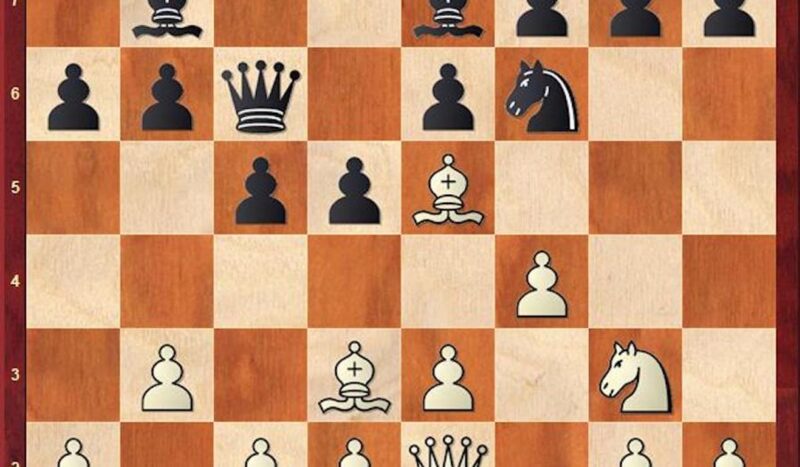Wishing all his readers and fellow chess fans a contented vacation and a ratings-enhancing 2024, David Sands is taking a break this week to work on his queen-and-pawn endgames. The next is a reprint of a column that first ran on Dec. 25, 2018.
It technically got here a day early, however the chess world was given a beautiful Christmas current 150 years in the past on Dec. 24, 1868, with the start of Emanuel Lasker within the German (now Polish) city of Berlinchen.
The younger mathematician would wrest the world chess title from Austria’s Wilhelm Steinitz in 1894 and maintain the crown for a file 27 years earlier than he was dethroned by Jose Raul Capablanca in 1921. He received a few of the most storied tournaments in historical past — London 1899, St. Petersburg 1909 and 1914, New York 1924 — and was nonetheless competing at a world-class stage towards a rising technology of masters into the Thirties.
Revered — maybe a bit an excessive amount of — as a grasp of the psychological points of the sport, Lasker was a superb tactician, a profound strategist and an underappreciated endgame specialist. He was the least dogmatic of the sport’s nice gamers, working up huge plus scores towards extra “scientific” rivals resembling Siegbert Tarrasch.
Tarrasch, Lasker as soon as mentioned, “admires an thought in chess for its depth. I love it for its efficacy. … I feel that by being sturdy, a transfer is gorgeous, too.”
His ruthless pragmatism makes Lasker one thing of an acquired style for a lot of, however a style that ages like a high-quality wine. “The older the participant is,” Russian-American GM Lev Alburt as soon as wrote, “the better the chances his idol is Lasker.”
It’s no chore to admire the huge variety of high-quality Lasker video games, resembling his win over English star H.E. Fowl in Fowl’s eponymous opening from an 1892 match. Black gambits a pawn for straightforward growth, places White’s items on awkward squares and cashes in with a intelligent successful motif.
Lasker has no compunction about buying and selling queens given the higher placement of his minor items, and secures a clamp on the place after 24. Be3 h3 25. Bxg5? (higher was 25. Kb2 g3 26. hxg3 h2 27. Rh1 Rg8 28. Rxh2 Ng4 29. Bg1 Nxh2 30. Bxh2 Rd8, and White’s nonetheless within the sport) g3! 26. hxg3 Rf1+ 27. Kb2 (Rd1?? hxg2! 28. Ne2 Bg4) Rxa1 28. Kxa1 h2 29. Rd1 Ng4, and White is tied up in knots.
Black cashes in with 33. Kd2 Rxe4! 34. Nd1 (Nxe4 Bxe4 35. Rc1 Bxg2 36. Kd3 c5 37. a3 h1=Q) Rd4+ 35. Ke2 Rxd1! 36. Rxd1 Be4 37. Rd8+ Kc7 38. Rd1 (Rh8 Bxg2 39. Rxh2 Nxh2 40. Bf4+ Kb6 41. Be3+ Kb5 42. Kf2 Ng4+ 43. Kxg2 Nxe3+ 44. Kf2 Nxc2 and wins) Bxg2 39. Bd8+ Kc8 40. Bb6 Bd5! (Lasker was not about to miss 40…h1=Q?? 41. Rd8 mate) 41. c4 h1=Q 42. Rxh1 Bxh1 and White resigned.
—-
Lasker famously based no college and picked up no disciples, however his affect and insights proceed to boost the trendy sport. In an 1889 sport towards Czech grasp Johann Bauer, Lasker first performed the two-bishop sacrifice that’s now a part of the fundamental grammar of combinational chess.
Choosing it up from the diagram, the place the unsuspecting Bauer as Black has simply performed 13…a7-a6, White uncorks 14. Nh5! Nxh5 15. Bxh7+! Kxh7 16. Qxh5+ Kg8 17. Bxg7!! — the magnificent second punch within the one-two mixture. The bishops rip the pawn cowl from the Black king, and the White queen and rook take it from there.
There adopted 17…Kxg7 18. Qg4+ Kh7 19. Rf3 e5 (the one method to cease quick mate) 20. Rh3+ Qh6 21. Rxh6+ Kxh6 22. Qd7! Bf6 23. Qxb7, and White went on to win simply in 38 strikes.
(Click on on the picture above for a bigger view of the chessboard.)
Fowl-Lasker, Newcastle-on-Tyne, England, August 1892
1. f4 e5 2. fxe5 d6 3. exd6 Bxd6 4. Nf3 g5 5. d4 g4 6. Ne5 Bxe5 7. dxe5 Qxd1+ 8. Kxd1 Nc6 9. Bf4 Be6 10. e3 Nge7 11. Bb5 O-O-O 12. Kc1 Bd5 13. Rg1 a6 14. Be2 Be6 15. Nc3 h6 16. Bd3 Ng6 17. Bxg6 fxg6 18. Rd1 Rde8 19. e4 g5 20. Bg3 Rhf8 21. b3 h5 22. Rd2 h4 23. Bf2 Nxe5 24. Be3 h3 25. Bxg5 g3 26. hxg3 Rf1+ 27. Kb2 Rxa1 28. Kxa1 h2 29. Rd1 Ng4 30. Rh1 Bf7 31. Kb2 c6 32. Kc1 Bg6 33. Kd2 Rxe4 34. Nd1 Rd4+ 35. Ke2 Rxd1 36. Rxd1 Be4 37. Rd8+ Kc7 38. Rd1 Bxg2 39. Bd8+ Kc8 40. Bb6 Bd5 41. c4 h1=Q 42. Rxh1 Bxh1 White resigns.
• David R. Sands may be reached at 202/636-3178 or by electronic mail at dsands@washingtontimes.com.








